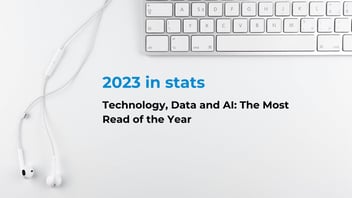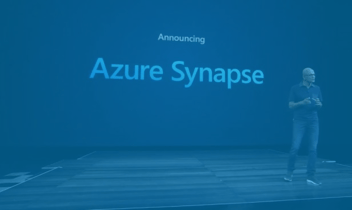We explain what data science is, what companies use it for and present the 10 best data science tools on the market.
Data science has become a critical facet of business. Most companies require data scientists to process, organise, transform and analyse their data so that it turns into valuable information. The growing importance of data science has led to the proliferation of a wide variety of data science tools and technologies. Below, we review the 10 best data science tools on the market.

In a previous blog post we talked about the importance of data, data science and data analytics to achieve data-driven decisions, i.e. informed decisions that contribute to improve a business' performance.
Technology and digitisation have transformed the market, which is now in constant transformation. In order to adapt to the market's volatility, organisations increasingly need information, knowledge and intelligence to make the right decisions. In addition, information is now required in real-time.
Thus, data has become one of the most valuable business assets and companies need experts to collect, integrate, treat and process their data. All these processes fall under one science: data science.
What is data science?
El concepto ciencia de datos o data science unifica todas aquellas actividades relacionadas con el tratamiento de datos que tienen como finalidad la obtención de conocimiento e información de valor —o, en el ámbito del business, insights—. Así, la ciencia de datos engloba técnicas de data analysis, de estadística y matemáticas, de visualización de datos, de informática, de integración de datos, etc. Es, por lo tanto, una ciencia interdisciplinar que abarca cualquier técnica aplicada al análisis y comprensión de fenómenos reales a partir de datos estructurados o no estructurados. Asimismo, la ciencia de datos está relacionada con otros procesos como la minería de datos, el aprendizaje automático, el data management, el data governance y el Big Data.
The concept of data science unifies all activities related to the processing of data with the aim of obtaining knowledge and valuable information —or, in business, insights—. Data science includes data analysis, statistics and mathematics, data visualisation, data integration, etc. It is, therefore, an interdisciplinary science that encompasses any technique applied to the analysis and understanding of real phenomena from structured or unstructured data. Data science is also related to other processes such as data mining, machine learning, data management, data governance and Big Data.
As the demand for data science has grown, so has the offering of data science tools. There are now a multitude of platforms, APIs and software through which data scientists can transform, consolidate, aggregate, modify and analyse datasets.
Here are the best data science tools on the market that any data scientist should know about. These technologies are extremely useful to increase the efficiency of projects, to develop new initiatives, to build data models, to analyse results, etc.
Top 10 data science tools
1. Azure Synapse
Azure Synapse, an evolution of Azure SQL, is a data analytics cloud service that allows you to analyse and store large amounts of data (Big Data). It is one of the most popular applications for computing complex data science projects. Ideal for large companies, Synapse allows to process, manage and serve data in a single service and is oriented to solve business intelligence needs.
One of the great advantages of Synapse is that, unlike other applications, it has artificial intelligence and machine learning capabilities, making it ideal for sophisticated projects. In addition, it makes it possible to query and manage large amounts of data and is compatible with many languages, tools, systems, software and programming frameworks —both from Microsoft and third parties—.
Azure Synapse is undoubtedly one of the most comprehensive data science tools on the market, integrating most of the other Azure tools. For example, it is integrated with Power BI and Azure Machine Learning; thus, it has machine learning mathematical model integration capabilities.
2. Azure Databricks
Azure Databricks is an ideal tool for data scientists who need to process and analyse data and work on projects collaboratively, as it has a collaborative and interactive workspace.
It is a computational system that allows high-speed programming of entire data clusters, complex queries and supports large amounts of data, execution of data in batches, streaming, etc.
Based on Apache Spark, this tool enables automatic scalability and is ideal for companies that need to process and analyse big data to draw conclusions. It also has capabilities for the development of artificial intelligence solutions.
Again, this tool can integrate with the other Azure services as well as Scala, R, Java, SQL and many other open source repositories and libraries. This allows scientists, engineers and analysts to work in multiple languages.
In addition, by integrating with Azure Machine Learning, it supports machine learning and the development of machine learning solutions.
3. Azure DataLake
Azure Data Lake es la herramienta ideal para aquellas organizaciones que necesitan un data lake de grandes capacidades. Un data lake es un servicio de almacenamiento de datos y, aunque puedan confundirse, no cumple las mismas funciones que un data warehouse.
Azure Data Lake is the ideal tool for organisations that need a large data lake. A data lake is a data storage service and, although they can be confused, it is not the same as a data warehouse.
Azure Data Lake is a cloud service that can store a large amount of data, of any size and in any format. It allows data scientists and analysts to carry out processing and analysis on different platforms and languages.
One of the great advantages of this tool is its high speed, which avoids the complexities of data entry and storage, speeding up the process of batch, streaming and interactive analysis. In addition, it supports debugging and optimisation of big data programs and allows parallel program development.
Like most Azure tools, it integrates easily with other data warehouses and applications.
It is an ideal application for enterprises, as it solves many of their data-related scalability and productivity challenges, and has support and audit capabilities that allow experts to control their data (data governance) and ensure its security.
4. Git
Having some knowledge in Git is a basic requirement for any data scientist, as it is one of the most widely used tools for creating source code.
This Microsoft subsidiary tool provides hosting for software development, source code management (SCM) and distributed version control.
Git has an online platform called GitHub. GitHub allows the hosting of open source projects, whereby many of the source codes are stored publicly. This turns the application into a kind of free code bank. Thus, this tool allows data scientists to display and publish their code blocks in the form of Gists, share their work and exchange knowledge with other data scientists.
Another of Git's advantages is that each project has functions for collaboration, access control, error tracking, feature requests, continuous integration, wikis and task management.
This tool has a free version that includes its basic services and a paid version with more advanced services for professionals and companies.
5. Azure Machine Learning
Artificial intelligence and machine learning are gaining relevance in the business world. Thus, Azure Machine Learning is as an increasingly essential tool for organisations that do not want to be at a disadvantage in data competition.
Azure Machine Learning is a complete data science platform that supports both code-first and low-code experiences to develop and manage projects.
The platform enables advanced options such as working with scalable compute clusters and end-to-end MLOps. In addition, Azure Machine Learning can be integrated with all Azure tools and other external open source tools.
6. DeltaLake
DeltaLake is an innovative open-source project created to enable users to store large amounts of data. The platform provides ACID transactions and leverages Spark's distributed processing for handling metadata.
In addition, DeltaLake supports petabyte-scale tables and allows developers to access and retrieve old versions of data for replaying experiments, re-versioning data or performing audits.
7. Power BI
Power BI is a set of business intelligence tools, software services and applications. It is oriented to the identification of KPIs and insights for better decision making. It is, therefore, an essential tool for the analysis and visualisation of data in business environments.
At Bismart, as a Microsoft Power BI partner, we have spoken on numerous occasions about this tool and its strengths. The most outstanding are its ability to connect to a large number of data sources of many sizes and in a wide variety of formats: relational and non-relational databases, other cloud services, Excel spreadsheets, data analysis web applications such as Google Analytics, Big Data tools, files in multiple formats, etc.
In addition, Power BI is an ideal platform for data visualisation. Power BI is the optimal technology for transforming data into understandable, customisable, interactive and visually stunning reports, dashboards or visuals.
- Learn the differences and potential of Excel and Power BI in this article where we compare the tools: "Excel VS Power BI: Which One is Better?".
8. Tableau
Tableau is another data analysis and data visualisation tool that allows the creation of intuitive and interactive visualisations in multiple formats: various types of graphs, geographic representations, etc.
It is primarily used to represent data geographically in a map format and, like Power BI, it is geared towards business problem solving and data visualisation as a business decision support tool.
Within the enterprise ecosystem, Tableau is a useful platform for analysts and data scientists, as well as for the IT department or the management team.
Finally, we cannot talk about data science without mentioning two of the most widely used data processing and management tools: Excel and the SQL programming language.
9. Excel
Microsoft Excel es uno de los programas más usados y conocidos de Microsoft. Como parte de Office 365, Excel fue creado en 1985 y es una de las plataformas más básicas para cualquier científico o analista de datos.
Microsoft Excel is one of Microsoft's most widely used and well-known programs. As part of Office 365, Excel was created in 1985 and is one of the most basic platforms for any data scientist or analyst.
Excel is based on a spreadsheet environment in which data can be sorted by rows and columns. Excel's great feature is that it allows you to apply calculations and formulas to data in a simple and agile way.
10. SQL
Although it is not a tool per se, SQL is, without a doubt, indispensable for any data scientist. SQL is a database-specific programming language that allows you to administer and manage data in SQL databases such as MySQL or Microsoft SQL Server.
Furthermore, mastering SQL is also necessary to work with other programming languages such as Python.
In short, the demand for data scientists continues to increase as businesses have a growing need for data for decision-making, driving efficient strategies, knowing their customers, optimising processes and operations and, in short, generating business intelligence.



